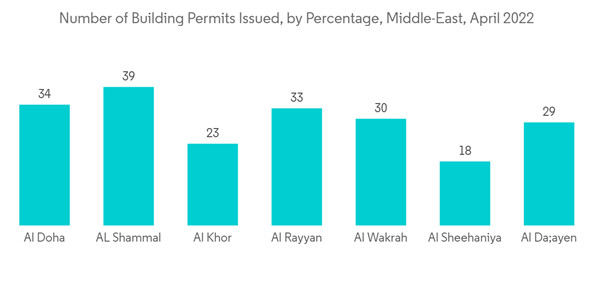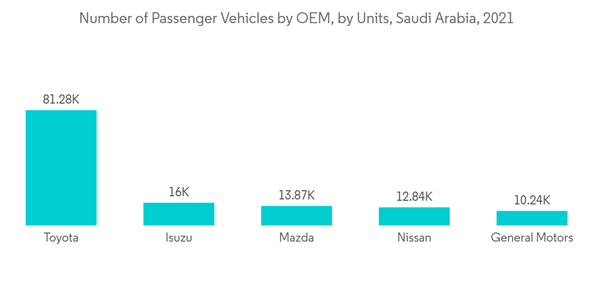The outbreak of COVID-19 adversely affected the automotive and transportation industries, resulting in all-time low sales and service of both new and used vehicles. Persistent lockdowns and curfews led to disruptions in the construction and heavy equipment manufacturing industries, which effectively dropped the demand for lubricant derivatives in the market. Disruptions in the supply chain also paved the way for an overall reduction in demand and supply in the lubricant market. However, the ease of travel restrictions, rise in transportation activities, and implementation of mass vaccination programs aided the growth of this sector in 2021 in the form of elevated automobile sales. Companies in the automotive market are putting a lot of money into making cars so that they can increase their production and sales.
Key Highlights
- A major share of demand for lubricant additives is expected from the Middle-East automotive industry. Benefitting from its strategic location and future-ready infrastructure, Dubai is perceived as the key automotive hub in the Middle East for the export of vehicles to the surrounding regions. The rising penetration of synthetic engine oil in the region is expected to be one of the major drivers within the automotive sector.
- However, supply chain disruptions and fluctuations in oil prices owing to geopolitical factors could potentially impact the supply of lubricant additives. Problems in the supply chain and logistics can cause problems like longer wait times for lubricant supplies, price changes, and less inventory.
Nevertheless, with major players mitigating the effect of supply chain disruptions with thorough inventory management, the demand and supply of lubricant additives are expected to stabilize during the forecast period. Key uses in power generation, heavy equipment, metallurgy, and metalworking are expected to further drive the demand in the next five years.
Middle East Lubricant Additives Market Trends
Increasing Consumption of Lubricant Additives in the Automotive and Construction Industry
- The automotive and other transportation segment is the major end-user industry for the lubricant additive market. Various types of additives are gaining popularity in the automotive industry owing to an increasing preference for materials that are energy-efficient, moisture-resistant, durable, and easy to use. Additives are used in more and more industrial applications because they are safe for the environment, people are becoming more aware of them and like them more, and laws in different countries require it.
- Lubricant additives are extensively used in gear oil, transmission fluids, engine oils, and hydraulic fluids, which are critical in the maintenance and service of vehicles. The demand for lubricant additives is bound to go up with the increasing number of vehicles plying the road. Dubai is expected to lead the growth in the automotive sector, favoring its strategic location and future-ready infrastructure.
- High-mileage engine oils are in demand lately, owing to their properties that help in the prevention of oil leaks and the reduction of oil consumption. Most light and heavy vehicle diesel and gasoline engines use 10W-40 and 15W-40 viscosity-grade oils.
- The light motor vehicle segment records the highest consumption rate of engine oils among all the segments. Because technology has gotten better and the government wants cars to use less gas, automakers are making lighter cars with tighter tolerances.
- According to OICA's world motor vehicle production, 57,056 vehicles were produced in 2021.
- The United Arab Emirates (UAE) were Around 209 thousand passenger cars were sold across the country in 2021, which was an increase compared to 154 thousand units in the previous year. Passenger car sales are expected to surpass 520 thousand units over the next four years.
- The total number of registered new vehicles during September 2021 has reached 7,388 new vehicles. The figure showed a monthly increase of 5.8% and an annual increase of 19.3%.
- Government spending will play a crucial role in boosting the growth of the construction sector. According to Qatar’s 2021 budget, new projects worth QAR 53.9 billion (USD 14.80 billion) were identified. These infrastructure-related projects will be awarded from 2021 to 2023.
- The Planning and Statistics Authority (PSA) said that Qatar gave out a total of 685 building permits in October 2021. Al Rayyan, Al Wakra, and Al Daayen municipalities made up as much as 65% of the total.
Taking into account all of the above, it is expected that the use of and demand for lubricant additives in the automotive and construction industries will grow over the next few years.
Saudi Arabia Region to Dominate the Market
- Saudi Arabia dominated the Middle East market with a significant market share and is projected to maintain its dominance during the forecast period. The significantly large consumption of lubricant additives across all types of automotive and construction activities in Saudi Arabia countries is the primary factor driving the growth of the target industry.
- According to the Organisation of Petroleum Countries (OPEC), the total production of 267.19 billion barrels of world crude oil belongs to Saudi Arabia.
- Saudi Arabia does not have an automotive production base. However, there is the presence of aftermarket services, which contributes a little to the market. The country is focusing on establishing itself as the new automotive hub in the Middle East. Though the country is a large importer of vehicles and auto parts, it is now trying to attract original equipment manufacturers (OEMs), to open their production plants in the country and develop the domestic auto industry which directly increases the usage of the additive.
- Saudi Arabia is the largest auto and auto parts market in the Middle East, accounting for ~40% of all the vehicles sold in the region. Saudi is the largest importer of the U.S. automotive products and parts in the Middle Eastern region, with some of these imports being re-exported.
- Saudi Arabia imported more than 320,000 cars during the first half of this year and the Saudi authority revealed the number of vehicles imported into the Kingdom during 2021 amounted to 562,000, up 2.9 percent on the previous year.
- The Saudi Arabian market is expected to provide huge opportunities for automobile manufacturers during the forecast period. As per LMC Automotive, the decision to allow women drivers has the potential to increase car sales by 15-20%, annually, in the country.
- Changing technology, downsizing of engines, and environmental regulations are some of the factors responsible for the expected increase in the consumption of these lubricant additives over the forecast period.
- The adoption of electric vehicles in Saudi Arabia is currently at an early stage. While the country's EV market is still small, Saudi investment in EV manufacturing abroad has been substantial. This is expected to decrease the demand for engine oil in automobiles.
- All the above-mentioned factors are likely to fuel the growth of the North American green building materials market over the forecast time frame.
Middle East Lubricant Additives Market Competitor Analysis
The lubricant additives market in Middle-East is fairly consolidated in nature. Some of the major players in the market include Abu Dhabi National Oil Company (ADNOC), TotalEnergies SE, ENOC Company, LANXESS, Exxon Mobil Corporation, BASF SE, and Others.Additional benefits of purchasing the report:
- The market estimate (ME) sheet in Excel format
- 3 months of analyst support
This product will be delivered within 2 business days.
Table of Contents
1 INTRODUCTION1.1 Study Assumptions
1.2 Scope of the Study
2 RESEARCH METHODOLOGY
3 EXECUTIVE SUMMARY
4 MARKET DYNAMICS
4.1 Drivers
4.1.1 Rising Synthetic Oil Penetration in the Region
4.1.2 Growing Automotive Sector in the Middle East
4.2 Restraints
4.2.1 Rising Raw Material Costs
4.2.2 Supply Chain Disruptions
4.3 Industry Value-Chain Analysis
4.4 Porter's Five Forces Analysis
4.4.1 Bargaining Power of Suppliers
4.4.2 Bargaining Power of Buyers
4.4.3 Threat of New Entrants
4.4.4 Threat of Substitute Products and Services
4.4.5 Degree of Competition
5 MARKET SEGMENTATION
5.1 Function
5.1.1 Dispersants & Emulsifiers
5.1.2 Viscosity Index Improvers
5.1.3 Detergents
5.1.4 Corrosion Inhibitors
5.1.5 Oxidation Inhibitors
5.1.6 Extreme-Pressure Additives
5.1.7 Friction Modifiers
5.1.8 Other Functions
5.2 Product Type
5.2.1 Engine Oil
5.2.2 Transmission and Hydraulic Fluid
5.2.3 Metalworking Fluid
5.2.4 General Industrial Oil
5.2.5 Gear Oil
5.2.6 Grease
5.2.7 Process Oil
5.2.8 Other Product Types
5.3 End-user Industry
5.3.1 Automotive & Transportation
5.3.2 Construction
5.3.3 Power Generation
5.3.4 Heavy Equipment
5.3.5 Metallurgy & Metal Working
5.3.6 Food & Beverage
5.3.7 Other End-user Industries
5.4 Geography
5.4.1 Saudi Arabia
5.4.2 United Arab Emirates
5.4.3 Iran
5.4.4 Qatar
5.4.5 Rest of Middle-East
6 COMPETITIVE LANDSCAPE
6.1 Mergers and Acquisitions, Joint Ventures, Collaborations, and Agreements
6.2 Market Share (%)**/Ranking Analysis
6.3 Strategies Adopted by Leading Players
6.4 Company Profiles
6.4.1 Abu Dhabi National Oil Company (ADNOC)
6.4.2 Afton Chemical
6.4.3 BASF SE
6.4.4 Chevron Corporation
6.4.5 Croda International PLC
6.4.6 ENOC Company
6.4.7 Evonik Industries AG
6.4.8 Exxon Mobil Corporation
6.4.9 Gunash Chemistry Industry Co-Ltd
6.4.10 Infineum International
6.4.11 Kemipex
6.4.12 LANXESS
6.4.13 Nouryon
6.4.14 Qhatran Kaveh Motor Oil Company
6.4.15 The Lubrizol Corporation
6.4.16 TotalEnergies SE
7 MARKET OPPORTUNITIES AND FUTURE TRENDS
7.1 Growing Popularity of High-performance Lubricants
Companies Mentioned (Partial List)
A selection of companies mentioned in this report includes, but is not limited to:
- Abu Dhabi National Oil Company (ADNOC)
- Afton Chemical
- BASF SE
- Chevron Corporation
- Croda International PLC
- ENOC Company
- Evonik Industries AG
- Exxon Mobil Corporation
- Gunash Chemistry Industry Co-Ltd
- Infineum International
- Kemipex
- LANXESS
- Nouryon
- Qhatran Kaveh Motor Oil Company
- The Lubrizol Corporation
- TotalEnergies SE










